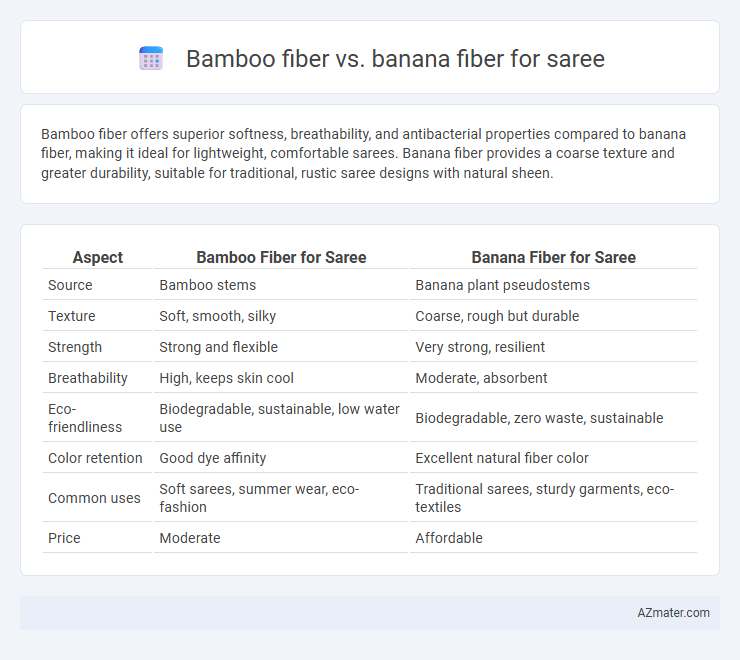Bamboo fiber offers superior softness, breathability, and antibacterial properties compared to banana fiber, making it ideal for lightweight, comfortable sarees. Banana fiber provides a coarse texture and greater durability, suitable for traditional, rustic saree designs with natural sheen.
Table of Comparison
| Aspect | Bamboo Fiber for Saree | Banana Fiber for Saree |
|---|---|---|
| Source | Bamboo stems | Banana plant pseudostems |
| Texture | Soft, smooth, silky | Coarse, rough but durable |
| Strength | Strong and flexible | Very strong, resilient |
| Breathability | High, keeps skin cool | Moderate, absorbent |
| Eco-friendliness | Biodegradable, sustainable, low water use | Biodegradable, zero waste, sustainable |
| Color retention | Good dye affinity | Excellent natural fiber color |
| Common uses | Soft sarees, summer wear, eco-fashion | Traditional sarees, sturdy garments, eco-textiles |
| Price | Moderate | Affordable |
Introduction to Eco-Friendly Saree Fabrics
Bamboo fiber and banana fiber are two popular eco-friendly options for saree fabrics, prized for their sustainability and biodegradability. Bamboo fiber offers a soft texture and excellent moisture-wicking properties, making it comfortable for everyday wear. Banana fiber is stronger and has a unique sheen, providing durability and an elegant finish ideal for traditional sarees.
What is Bamboo Fiber?
Bamboo fiber, derived from the pulp of bamboo plants, is a sustainable and eco-friendly textile known for its softness, breathability, and natural antibacterial properties. It is highly absorbent, moisture-wicking, and resistant to odors, making it ideal for comfortable, lightweight sarees. Compared to banana fiber, bamboo fiber offers a smoother texture and better drape, enhancing the elegance and wearability of sarees.
What is Banana Fiber?
Banana fiber is a natural textile fiber extracted from the pseudostems of banana plants, known for its strength, durability, and eco-friendliness. It produces lightweight, breathable fabric with a unique texture, ideal for traditional Indian sarees that combine comfort and elegance. Compared to bamboo fiber, banana fiber offers a coarser, more rustic look, often preferred for artisanal and sustainable saree designs.
Sustainable Sourcing: Bamboo vs Banana
Bamboo fiber for sarees is derived from fast-growing bamboo plants that require minimal water and pesticides, making its sourcing highly sustainable and eco-friendly. Banana fiber, extracted from the stalks of banana plants, utilizes agricultural byproducts that would otherwise be discarded, promoting zero-waste practices and reducing environmental impact. Both fibers offer renewable sourcing options, but bamboo's rapid growth rate provides a more consistent and scalable supply compared to seasonal banana harvests.
Texture and Comfort Comparison
Bamboo fiber offers a smooth, silky texture that feels soft and breathable, making it ideal for lightweight sarees with excellent moisture-wicking properties. Banana fiber, on the other hand, exhibits a coarser texture with a natural stiffness, providing durability and a slightly rustic appeal while maintaining good comfort in warmer climates. Both fibers are eco-friendly alternatives, but bamboo sarees prioritize softness and drape, whereas banana fiber sarees emphasize robustness and structure.
Durability and Maintenance
Bamboo fiber sarees exhibit high durability due to their strong, naturally antimicrobial fibers, making them resistant to wear and tear while requiring minimal maintenance such as gentle hand washing and air drying. Banana fiber sarees, derived from banana plant stems, offer robust strength and longevity but need careful maintenance to avoid stiffness, often benefiting from regular conditioning and delicate washing. Both fibers provide eco-friendly options, with bamboo being easier to maintain and banana fiber requiring more attention for sustained durability.
Color Retention and Dyeing Properties
Bamboo fiber and banana fiber both offer unique advantages in saree fabric dyeing, with bamboo fiber exhibiting superior color retention due to its smooth surface and high absorption capacity, resulting in vibrant, long-lasting hues. Banana fiber, though coarser, accepts natural dyes well and imparts a subtle, earthy tone to sarees but tends to fade faster under prolonged sunlight or washing. The choice between bamboo and banana fiber for sarees depends on desired color vibrancy and durability, with bamboo providing more consistent and enduring color outcomes.
Cost and Accessibility
Bamboo fiber sarees generally cost more due to the complex extraction and processing methods, while banana fiber sarees are often more affordable as the fiber is obtained from banana plant stems, which are readily available as agricultural waste. Accessibility for bamboo fiber sarees can be limited by the need for specialized manufacturing facilities, whereas banana fiber sarees benefit from the widespread cultivation of banana plants, especially in tropical regions, making raw materials easier to source. Market availability for banana fiber sarees tends to be higher in rural areas, while bamboo fiber sarees are predominantly found in niche, eco-friendly textile markets.
Fashion Trends: Bamboo and Banana Fiber Sarees
Bamboo fiber sarees are gaining popularity in sustainable fashion due to their eco-friendly nature, breathability, and silky texture, making them ideal for contemporary saree designs. Banana fiber sarees offer a unique rustic appeal with natural sheen and durability, resonating with ethnic and artisanal fashion trends. Both fibers contribute to the rise of biodegradable textiles in saree fashion, aligning with the growing demand for eco-conscious and stylish apparel.
Which is Better for Sarees: Bamboo or Banana Fiber?
Bamboo fiber offers a silky texture, excellent moisture-wicking, and natural antibacterial properties, making it ideal for lightweight and breathable sarees. Banana fiber, known for its durability and coarse texture, provides a rustic appearance and longer lifespan but may feel stiffer against the skin. For sarees, bamboo fiber is better suited due to its softness and comfort, while banana fiber appeals to those seeking eco-friendly, sturdy textiles with a traditional look.

Infographic: Bamboo fiber vs Banana fiber for Saree
 azmater.com
azmater.com